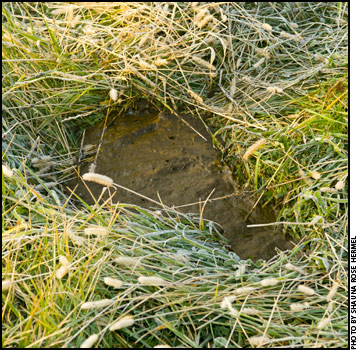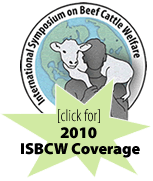HEALTH & NUTRITION...
 Manure Consistency
Manure Consistency
How does it stack up for your cattle?
Some animal nutritionists have devoted much time and effort to observation and evaluation of cow manure. This writer recently stumbled upon an old magazine story with an intriguing title: "Manure Connoisseur." The article explained how researchers used a system for scoring manure on the basis of its consistency. At one end of the numerical scale (1 through 5) was manure of a fluid nature, while the other extreme applied to manure that was fairly dry. Numbers 2 through 4 described the in-between stages in a progression from manure that's sure to splatter to that which is more stackable.
The take-home message of the story was that producers might learn something from cow manure. Its consistency offers clues to the adequacy of the cattle diet. Of course, sickness can influence the appearance of manure. If cattle are healthy, however, the consistency of their manure is largely determined by nutrition. Read more.
Functional Amino Acids Regulate
Key Metabolic Pathways
Functional amino acids play a critical role in the development of both animals and humans, according to a Texas AgriLife Research scientist.
In a journal article appearing in the latest edition of the American Society for Nutrition (Advances in Nutrition, 1:31-37, 2010), Guoyao Wu, AgriLife Research animal nutritionist and senior faculty fellow in the department of animal science at Texas A&M University, calls for scientists to "think out of the box" and place more emphasis on this area of study.
"We need to move forward and capitalize on the potential of functional amino acids in improving health and animal production," he said. Read more.
Managing Pain in Cattle

The lack of analgesic compounds approved for cattle in the United States represents a significant challenge to producers.
Societal concern for the humane care of food-production animals is only one reason why veterinary pharmacology researchers, like Kansas State University's Hans Coetzee, are looking for ways to better manage animal pain. Another reason is that more effective pain management could help livestock producers optimize animal performance and the economic sustainability of their operations.
Speaking before the International Symposium on Beef Cattle Welfare, Coetzee said there are no easy answers to effective mitigation of animal pain in the production environment. There are different types of pain to manage. Acute pain may be managed through local or general anesthesia or sedatives, while chronic pain may require anti-inflammatory drugs applied more specifically for control of neuropathic pain. And some procedures, including castration and dehorning of cattle, may be accompanied by both kinds of pain. Read more.

Rick Rasby
Ridin’ Herd
Grazing cornstalk residues: What do you need to supplement?
In many areas of the United States, cornstalk residue is available in the fall and winter for beef cows to graze. Allowing cows to harvest their nutrient needs is a lot more economical than carrying harvested forages to them. Grazing cornstalk residue is effective in reducing feed costs.
There are data from Nebraska and Iowa that indicate grazing corn residue in the fall and winter does not impact subsequent grain yield. If weather conditions in the spring make fields muddy, it may be advisable to remove cows from the fields. These weather conditions can occur in March in Nebraska.
Residue grazing is an important management practice for many cattle operations — primarily as either a winter feed resource for maintaining the breeding herd or putting weight on cull cows. A common question seems to be: Do I need to supplement the cows with something other than salt and mineral while they graze cornstalk residue?
Invest Now, Save Later
Using treatments effective against Mycoplasma bovis can help save money on re-treatments later.
When trying to strengthen the bottom line and cut costs, many cattle producers often turn first to less expensive treatments. When dealing with serious challenges that contribute to bovine respiratory disease (BRD), like Mycoplasma bovis, choosing treatments that are effective to start with can prove less expensive in the long run, according to Veterinarian Daniel Scruggs, Veterinary Operations, Pfizer Animal Health.
"Producers often forget their total cost for antibiotics isn't what they pay up front, it's what they pay for the first, second and third treatments," Scruggs says. "Re-treatments for BRD — especially M. bovis-related disease — can cost producers a lot of money." Read more.
Trace Minerals Crucial for Cattle Health
During the past two decades, USDA studies of blood levels for trace minerals in cattle herds around the country found numerous animals deficient in four important minerals — selenium (Se), copper (Cu), zinc (Zn) and manganese (Mn). Reproductive performance in cattle, skeletal development in young animals, optimum health, and strong immunity depend on adequate nutrition — which includes important trace minerals. Read more.
Trace Minerals in Feedlot Cattle
Most feedlots add supplemental minerals to a grain ration, but feed consumption of shipping-stressed cattle coming into a feedlot is typically low, especially the first seven to 10 days. Some feedlots individually dose the animals.
Recent studies have evaluated performance of shipping-stressed cattle receiving injected minerals vs. performance of cattle that did not receive this supplement, and how trace mineral status affects risk for respiratory disease and finishing performance in feedlot cattle. Read more.
Cattle Diseases: Common Conditions/Terms
Click here for a list of common conditions and terms related to beef cattle diseases, such as anaplasmosis, brucellosis, BVD, E. coli, IBR and others.
[Click here to go to the top of the page.]





